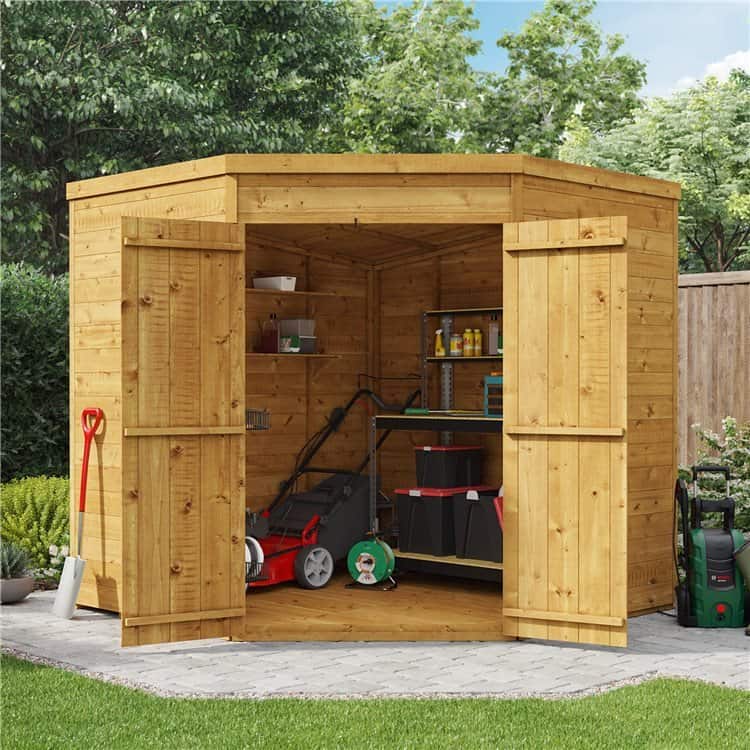Jump to:
As the UK welcomes the vibrant colours of fall, another annual tradition begins to take centre stage. Spring cleaning. While homeowners eagerly tackle various cleaning projects, one crucial area often goes unnoticed, a.k.a. garden sheds.
This is the time of year where sheds become a vital hub for tools, supplies, and organisation. It serves as the gateway to your gardening adventures for the rest of the season.
Investing a little time and effort will yield significant benefits. But there’s more at stake than just decluttering this time of year, and we’ve got you covered!
Garden Spring Cleaning: Sheds

When it comes to storage, sheds often bear the brunt of our impulse to stow away unused items. As a result, they can quickly spiral into disarray and become a dumping ground.
The challenge lies in finding the right time to get started on the cleaning process. Depending on the current state of your shed, it may require a full day of dedicated effort. Yet, if done effectively, it can provide peace of mind and alleviate the need for future cleanouts.
But what exactly does shed spring cleaning entail? It goes beyond simply tidying up and decluttering. It involves creating an efficient and functional space that supports your gardening endeavours. From organising tools and equipment to optimising storage solutions, you name it.
Imagine your shed as an extension of your home or an outdoor living space. A clean and organised household can boost your immune system and reduce stress. The same goes for a well-maintained garden shed, offering the same positive impact.
Get ready to unlock the full potential of your garden shed this coming season!
Shed spring cleaning #1: Clean out your shed

Have you been utilising your shed as a dumping ground for your:
- outdoor belongings
- excess and bulky stuff from your home
- other miscellaneous objects
If so, it’s time to roll up your sleeves and start by sorting out everything. Group all your tools, equipment and other stored goods, then sort out what you use regularly.
For example, set aside essential gardening tools for spring garden prep. Simultaneously, be ruthless in disposing of anything broken or seldom used.
Once you’ve narrowed down your collection, sort the remaining items into piles based on their use. Arrange frequently used tools near the shed entrance for easy access. As for those seasonal items like Christmas decorations, place them in a labelled box. You can store them in a less accessible spot.
To maximise space and maintain an organised shed, install shelves, hooks, or pegboards. These additions provide designated areas for hanging tools and keeping everything within reach.
Shed spring cleaning #2: Make way for new storage

Take this as an opportune time to assess your storage needs and create space for new items. Take stock of the belongings currently occupying your shed. Keep an eye out for winter gear like snow blowers and sledges that can be stowed away until the next snow season.
To accommodate these bulkier items, clear out any unnecessary objects taking up space. This process can be seamlessly integrated into your shed cleaning routine mentioned earlier.
After decluttering, consider the best storage solutions for your specific needs. Utilise vertical space so you can free up valuable floor areas. Here are some storage organisation tips to optimise your shed space:
- Install open shelving units to make the most of your shed’s height.
- Wall-mounted pegboards can keep your tools within reach while maintaining your workspace clutter-free.
- If you’re using your shed as an office, consider clear, stackable storage containers. These containers are ideal for storing ink cartridges, paperwork, and other office essentials.
Revamp your shed’s storage and welcome a clutter-free environment this spring!
Shed spring cleaning #3: Give your garden tools a little love
You may haven’t used your gardening tools over the winter while your garden lay dormant. Now is the perfect time to give both your garden and tools some well-deserved attention.
Begin by wiping off any surface rust, dirt, and grime. This can include your shovels, shears, trowels, and other garden equipment. Once cleaned, return them to their designated storage spaces or hang them securely. With the arrival of spring, your tools will be ready for action in the new season.
Cleaning your garden tools regularly is a must. But it’s also particularly important to prepare them for winter storage. Ideally, clean them after each use. Ensure they are thoroughly cleaned before being put away for the cold season.
Shed spring cleaning #4: Check for unwanted visitors
Winter serves as a refuge for pests seeking shelter from the cold. And your shed can become an attractive target for these desperate creatures. As you embark on your shed spring cleaning journey, safeguard it from becoming a home for them.
Here are essential steps to keep your shed pest-free:
- Trim vegetation. Clear any overgrown vegetation or branches around your shed. Trim back shrubs and trees to create a buffer zone, making it harder for pests to access your shed.
- Firewood storage. Avoid stacking firewood directly next to or inside your shed. Woodpiles can serve as hiding spots, e.g. for insects and rodents, which can easily make their way into your shed.
- Garbage management. Never store garbage cans or waste containers inside your shed. Keep garbage cans well away from your shed, ideally in sealed bins.
- Secure containers. Ensure all containers and bags within your shed are tightly sealed. Bugs have a keen sense of smell and can find their way in if they detect enticing scents.
- Standing water. Prevent the accumulation of standing water in and around your shed. Pests often lay their eggs in stagnant water, so regularly check for any sources of water.
By implementing these measures, you can enjoy a pest-free sanctuary for your tools.
Shed spring cleaning #5: Do necessary repairs and touch-ups

- Roofing maintenance. Inspect the roofing for any signs of wear and tear. For any damage, replace it with new felt to prevent leaks and further deterioration.
- Termite and leak check. Examine your shed for signs of termites and leaks. Look for mud tubes, wood damage, or water stains. Address any issues promptly to avoid extensive damage and costly repairs.
- Rust and corrosion inspection. If you own a metal shed, carefully inspect it for signs of rust and corrosion. Treat any affected areas and apply a protective coating to prevent future corrosion.
- Weatherproofing. Ensure your shed is adequately weatherproofed to protect it from the elements. Consider applying weatherproof sealants to gaps, cracks, and joints to prevent water infiltration.
- Insulation and moisture control. Proper insulation is essential to protect your belongings from condensation and prevent leaks. Ensure your shed has well-sealed flooring and windows. Avoid storing damp items inside, and ensure everything is thoroughly dry before storage.
- Exterior makeover. After cleaning the shed’s interior, give the exterior a fresh makeover. Consider applying a new coat of paint to revitalise its appearance. Opt for a green-toned paint to blend with the natural surroundings. Or, choose a neutral tone like beige or tan to make it stand out.
Not only will this enhance the aesthetic appeal of your shed, but also protect it from further damage.
Round-up
With a bit of time and effort, you can turn your shed into a spring-ready garden haven. Make sure to keep this shed spring cleaning guide and make the most out of it throughout the season. Come summer, then fall, and you find yourself preparing your shed for winter already!





